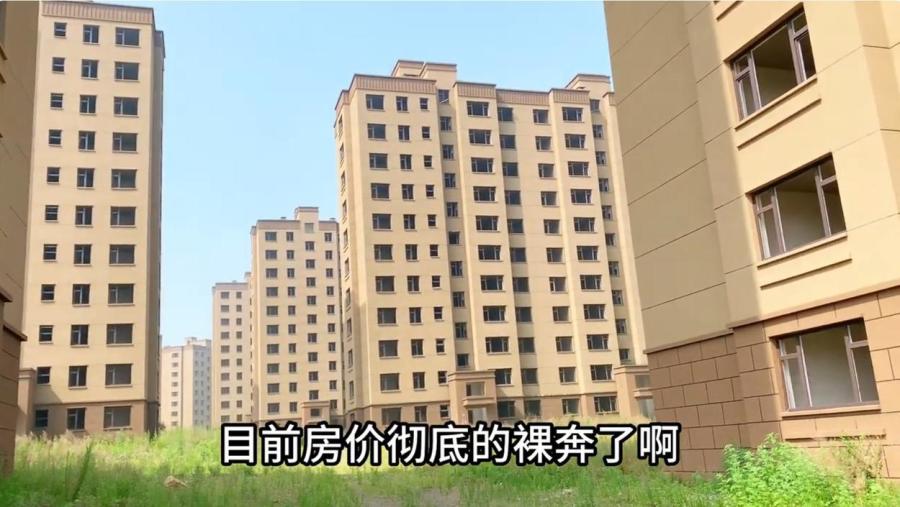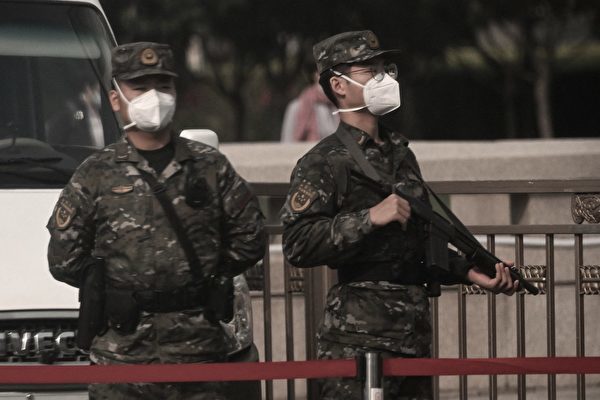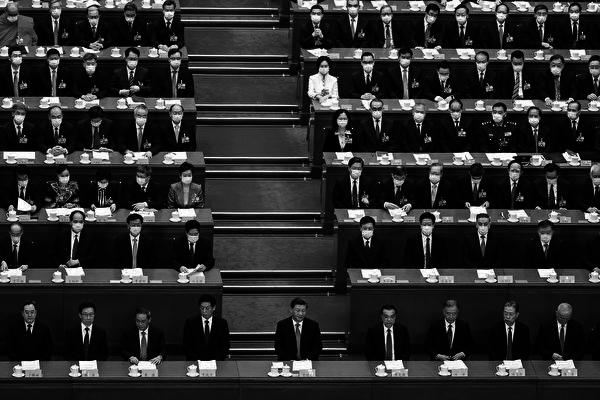In China, vast numbers of vacant buildings can be seen everywhere, standing like rows of tombstones—an eerie and shocking sight. (Screenshot from video)
[People News] On July 30, the Chinese Communist Party (CCP) convened its Politburo meeting to set the economic agenda for the second half of the year. The meeting emphasised the need for continued macroeconomic support and timely policy intensification, stating that policy must “maintain continuity and stability while enhancing flexibility and foresight.” It also highlighted the importance of curbing “involution” and implementing more proactive fiscal policies along with appropriately loose monetary policy.
July Politburo Meeting Fails to Mention Real Estate
What drew particular attention was the Politburo’s rare omission of any mention of the real estate sector—raising questions about future policy direction for the housing market in the second half of 2025.
Just two weeks earlier, on July 14–15, the CCP held a high-level Central Urban Work Conference in Beijing. Many anticipated that the Party would launch “Shantytown Redevelopment 2.0” during this meeting. However, the outcome was just a broad, vague vision for “urban renewal”—with no concrete shantytown policies announced. The much-anticipated stimulus package failed to materialise.
Does this contraction in official housing policy suggest that the national property market has stabilised and is rebounding? Clearly not. According to data from the National Bureau of Statistics, in the first half of 2025, National real estate development investment was RMB 4.6658 trillion, down 11.2% year-on-year. The total floor area of new housing starts was 303.64 million square meters, down 20.0%. Residential housing starts were 222.88 million square meters, down 19.6%. Commercial housing sales reached 458.51 million square meters, down 3.5%. Housing completions totalled 226 million square meters, down 14.8%. Developers’ available funds were RMB 5.0202 trillion, down 6.2%. Down payments and pre-sale payments were RMB 1.4781 trillion, down 7.5%. Individual mortgage loans totalled RMB 684.7 billion, down 11.4%.
It appears the CCP has realised that past stimulus efforts have had a limited impact. Each round of policy only brought a brief boost in transaction volume (“trading quantity for price”), but home prices continued to fall. This price drop is evident across both new and second-hand housing, in first-tier and lower-tier cities, and across core and peripheral locations. Developers took advantage of brief policy tailwinds to offload inventory quickly.
On a structural level, China’s bubble-driven real estate model has reached its limit. Since housing reforms began in 1998, China’s property prices have surged dramatically: The national average price per square meter rose from RMB 2,000 in 1998 to RMB 11,000 in 2021—a 5.5x increase. In top-tier cities like Shanghai and Shenzhen, prices rose from RMB 3,000/sq.m to RMB 65,000/sq.m—over 20x growth. Now, with China’s economy collapsing, local governments mired in debt, a plummeting population, excessive household leverage, and governance based on political campaigns, real estate has entered a phase of sharp decline.
The downturn in real estate is not just a bottleneck—it’s a full-blown crisis. Real estate is not only the backbone of China’s economy but also its financial lifeline. As of 2024, Chinese household debt accounts for 62% of GDP, up from 19% in 2010, and around 70% of that debt is mortgages. Meanwhile, local government financing platforms (LGFVs) borrow from banks to acquire land. A sharp housing crash could trigger systemic financial risk. Some major state-owned developers, such as Vanke, have already borrowed over RMB 20 billion from the Shenzhen Metro Group, tying them tightly to state-owned capital.
Recently, Ye Cun Securities predicted that China’s economy will hit another turning point in mid-2025, warning of a cliff-like drop in demand. Economist Lu Ting’s team added that weakening export demand, a slowdown in “trade-in” consumer stimulus, slumping mid-to-high-end consumption and dining, and mortgage burdens will cause a severe contraction in overall demand. The real estate sector will worsen further, with most cities seeing deteriorating conditions.
July Real Estate Market Declines Further
On July 21, China Index Academy released its "2025 Jan–July Real Estate Sales Rankings": Top 100 developers posted RMB 2.07301 trillion in total sales, down 13.3% year-on-year. July alone saw an 18.2% drop in year-on-year sales, widening from the 11.8% drop seen in the Jan–June period.
By sales tiers: Only 5 developers surpassed RMB 100 billion in sales, one fewer than last year. The 500–1000 billion yuan group had 6 developers, unchanged. The 300–500 billion yuan tier had 4 companies, one less than last year. The 100–300 billion yuan tier had 34 firms, unchanged.
As for second-hand homes, data showed: In July 2025, the average price in 100 cities was RMB 13,585/sq.m, Down 0.77% MoM, and down 7.32% YoY—a larger decline than in June. First-tier city prices also fell: Beijing: -0.61%, Shenzhen: -0.55%, Shanghai: -0.57%, Guangzhou: -0.82%.
Beijing’s second-hand home transactions: 12,784 units in July, down 15.56% from June (15,139 units), down 17.92% from July 2024 (15,575 units). Example price collapses: Sunshine Upper East: A 139㎡ 2-bedroom unit sold in July 2025 for RMB 7 million, down from RMB 12.75 million in Sept 2021—a 45% drop. Wangjing New Town: A 92㎡ unit sold for RMB 4.18 million, down from RMB 7.09 million in Aug 2021—a 41% drop.
Beijing SOEs Dump Over 300 “New Homes”
According to Chinese media, Beijing’s Chaoyang District State-Owned Assets Supervision Commission (SASAC) plans to offload over 300 units in Morning Light Garden (C Area). These are unfinished "new homes," with Lower-floor units priced at ~RMB 55,000/sq.m. Middle-floor units at ~RMB 60,000/sq.m. Sold via dynamic pricing and open bidding. Currently in the buyer registration stage, with viewings to follow.
The 300 units equal the past six years of second-hand transactions in the complex—dumping this many units at once will act like a price-crashing bomb for Morning Light Garden and nearby properties. It’s likely to spark a pricing war in Beijing’s stock housing market, leading to a brutal “priced but unsold” situation.
Located just 1km outside Beijing’s East Fourth Ring, Morning Light Garden is part of the Shilibao area. These homes were built over a decade ago but left unsold. Now, if buyers use official renovation firms, they may receive a 2% rebate on the purchase price.
This isn’t Chaoyang SASAC’s first fire sale. In May 2025, it was reported to be offloading about 300 units in Shihua Boyun (New Beiyuan), priced at RMB 60,000/sq.m. At the time, Lianjia’s listed price for that area was RMB 77,000/sq.m—a 30% discount. Back in September 2023, Chaoyang SASAC sold 154 apartments in China Railway International City at below-market prices (~RMB 87,400/sq.m). From Feb to July 2024, more batches were offloaded at RMB 75,000–80,000/sq.m.
From China Railway International City to Shihua Boyun, and now to Morning Light Garden Area C—these are all prime-location projects that have sat idle for over a decade. Why is the Chaoyang District State-Owned Assets Supervision Commission (SASAC) only now entering the market? The reason is clear: the overall environment and market outlook for Beijing real estate have turned unfavourable. While liquidity still exists, it’s better to sell early and cut losses than to wait.
On another front, Goldman Sachs recently pointed out that the Chinese government's debt has reached a staggering 179 trillion yuan. As the local government debt crisis unfolds, activating state-owned assets has become a mandatory task to ease financial strain. In November 2022, the Ministry of Finance issued the Guiding Opinions on Activating State-Owned Assets of Administrative and Institutional Units, explicitly calling for the accelerated utilisation of assets such as housing, land, and vehicles, to improve asset efficiency and genuinely implement the directive to “tighten belts.”
As for whether this disrupts the market, accelerates the race to the bottom in housing, or crashes the second-hand housing sector, the local officials, eager to show political achievement and preserve their official hats, couldn’t care less about how much the “cattle and horses” (ordinary people) see their assets shrink.
(First published by People News)











News magazine bootstrap themes!
I like this themes, fast loading and look profesional
Thank you Carlos!
You're welcome!
Please support me with give positive rating!
Yes Sure!